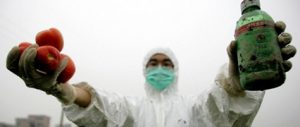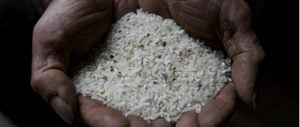Wang Guowei heads up the policy and legislation department at the State Council Food Safety Commission. He spoke to Xu Nan and Zhou Wei about the nature of China’s food safety problems and the on going policy response.
chinadialogue: Compared with other countries, what are the key characteristics of China’s food-safety problems?
Wang Guowei: Developing a modern agricultural and food industry brings many benefits, but it also brings food safety risks. Bacteria, pesticides, veterinary drugs, heavy metals, natural toxins, organic pollutants, the adding of harmful substances – these are relatively common worldwide. In the United States, one sixth of the population suffers from foodborne illness in any given year, and 3,000 of them die.
Inevitably, these same issues exist in China. But China also has its own characteristics. For example, food production is small-scale, scattered and poorly organised. Market arrangements aren’t ideal, social trust mechanisms are incomplete. Although a market economy is in operation, awareness of the rules of a market economy hasn’t matured, meaning that producers have a weak understanding of quality and safety. This leads to more cases where harmful foodstuffs are deliberately produced.
But what I want to stress is that the Chinese people’s understanding of food safety is still poor, even to the point of missing what’s important. There’s lots of talk about counterfeit foods, but few people are aware of the real food safety issues affecting the country. Recycling out-of-date steamed buns, for example, is consumer fraud – but it doesn’t pose health risks, and it’s a practice that will stop as regulation and the market improve. Meanwhile, the contamination that has accompanied the industrialisation of food production receives too little attention. The public are upset about fake food products and the authorities are busy responding to those concerns, limiting the development of technological capacity and even reducing how scientific some systems are. That’s something society as a whole needs to consider. For their part, the authorities should work hard and take more responsibility, and genuinely bring food safety risks under control.
That China’s food companies are small, scattered and poorly organised is a feature of the country’s “growing pains”. On the other hand, food monopolies in the west leave regulators powerless and create systemic risks. There are problems in both cases. When planning for development of the food industry, there should be a balance between scale and diversity. As for who has the better regulations or who is at less risk from food safety problems, you can’t really make the comparison. A recent TV programme about food, “Bite of China”, showed just how many different types of food China has, its countless different snacks. Even if you have big companies, you can’t get rid of all the little places, and that’s always been the case because of China’s food culture.
cd: How would you summarise the situation you face as policymakers?
WG: In our food safety work, we face four “mismatches”. First, problems are very common, and the food-safety situation falls short of public demands.
Second, there is a mismatch between our regulatory powers and our regulatory obligations. Our tools need to be improved. In particular, we have a severe lack of enforcement powers. We have 106,000 regulatory staff, but 10 million registered businesses to watch, and that doesn’t include the tradespeople and hawkers or 280 million farmers.
We must learn from international practices. Rather than using bolted on methods such as random sampling and acting after problems arise, we need to use national food-safety standards to monitor, evaluate and provide early warning of risks, enforce the law and carry out inspections, bringing together regulation of both production and product. We need to be scientific and professional. Food-safety regulation is professional and technical work. Currently, we are very weak in this area.
Third, there is a difference between public understanding of food safety and actual circumstances. The problems aren’t so bad that you should be scared to eat. We haven’t had big outbreaks of food-borne illnesses like you saw last year in Germany and this year in the United States. The media do report a lot of problems, but a fair proportion of those stories turn out not to be true. We welcome media supervision, but it needs to be accurate and objective. You could joke that panicking about food is more dangerous to health than the harmful food itself.
Fourth, there’s a difference between the environment for public debate on food safety, and the requirements of social harmony. It doesn’t matter how big a food safety issue is, it’s a specific and specialised issue – an issue of whether or not regulatory mechanisms are working, whether or not technological abilities are sufficient. But there’s an unfortunate trend to talk about it as a social problem. Sixty years of peaceful living seems to have made us forget the history China has seen – the war, the upheaval, the changes of government – we never used to have the leisure to discuss quality of life issues like food safety. All discussion about food safety should focus on constructive solutions. China’s harmony and stability benefit the people.
cd: What are the key reasons for these “mismatches”?
WG:First, our stage of development is significant. I have mentioned the quality of the production sector, the trust deficit, market rules. And of course, the quality of our work is also determined by this. We have only recently solved issues of sustenance – food safety supervision has got off to a late start and there’s still a lot of work to do.
Second, people think that these problems have suddenly arisen, but many of the problems were already here. Artificial sweeteners, food dyes in snack foods – in the past nobody worried about this sort of thing, but now everyone is suddenly concerned and upset.
Third, once basic living standards have been achieved, people start to worry more about their health and quality of life. They start looking for healthy and safe food, and life is more respected.
Fourth, media reports and trends in public debate play a role. The media brings attention to certain matters, but that has two effects on public opinion: incidents get connected – both the media and the public will link the current incident with similar ones in the past. And when an incident occurs in one area, people living in different areas start worrying that the same problem may be exist there.
cd: How does the government regard food safety issues? What is the place of food safety work?
WG: In the 30 years since reform and opening up, China rapidly solved its food-supply issues. Once sustenance was assured, food safety became an issue, and after the Sanlu milk powder scandal in 2008 attracted unprecedented concern, it became a major and difficult issue. The government’s understanding of this has deepened over time.
The 1993 Food Hygiene Law was mostly concerned with hygiene – society, including the government, didn’t have a full understanding of food safety, and there are fundamental differences in the focus of law and regulations between then and now. The 2008 Sanlu milk powder scandal marked the start of an outbreak of problems, and in 2009 the Food Safety Law marked the government doing more. Since then, the government has been strengthening overall food-safety management.
cd: China has always struggled with problems that come from different bodies being responsible for regulating the same sectors, and that’s hard to change. When it comes to food safety, how do the mechanisms and systems need to be improved?
WG:Currently the government is working to improve several aspects of food safety work.
Firstly, the management systems that were set up when the country was focused on ensuring food supply need to be changed. Originally, the Ministry of Agriculture was in charge of the production of agricultural products, the General Administration of Quality Supervision was in charge of food companies, the State Food and Drug Administration was in charge of restaurants and caterers, the industrial and commercial authorities were in charge of the sale of products on the market – that kind of fragmented management creates frictional costs and makes end-to-end management impossible. So the State Council Food Safety Commission Office has been set up to oversee the different authorities. When problems arise, they will be dealt with jointly – there will be overall coordination.
Of course, whether or not this is thorough enough, whether or not regulatory resources need to be further integrated, that’s still being discussed and the authorities are examining these questions. Reform needs consensus and active and steady implementation.
Second, regulation is being strengthened. In 2009, we passed the Food Safety Law and set up risk monitoring, evaluation and early-warning systems. In 2010, the Food Safety Standards Evaluation Committee was formed, and in 2011 we founded the Food Safety Risk Evaluation Centre. And our push for more professional and more scientific food safety regulation has only just got started.
Take a piece of chocolate. We need to set standards for some of the ingredients, and then monitor compliance. If a standard isn’t met, we regard it as unsafe. But even if a company works entirely according to its processes, it can’t guarantee that standards will be met completely – there can always be some accidental contamination. So there needs to be a permitted amount of problem foods, and if that amount is exceeded, then we penalise the company. This needs scientific standards.
But you can’t test for substances that you never expect to be there, so you can’t catch all possible harmful substances. Every year, the government publishes a blacklist of harmful substances likely to be added to food because they can increase profits, and then testing methods are determined. Companies then design testing equipment, which the government purchases, and then you’ve got a new method of enforcing the law. Only when these are part of law enforcement standards, will regulation be effective.
Monitoring by enforcement agencies is the basis of penalising companies. The Food Safety Risk Evaluation Centre, set up in 2011, is a risk-monitoring system that sits outside that enforcement structure. It has numerous monitoring stations around the country, collecting 400,000 pieces of data annually. Unlike other monitoring efforts, this work isn’t limited to testing against certain indices – they use very sensitive equipment, take random samples and are in touch with medical bodies. It’s not for law enforcement, it’s for overall analysis. Nonetheless, risk monitoring remains very weak, and that’s going to be a focus for development in the future.
And a whole series of systems and mechanisms is still to be set up. Already, there are new rules for market access for makers of all 28 major categories of food and we’ve established a safety evaluation system for new types of foods, food additives and ingredients. When any food product leaves the factory, it is subject to standard monitoring. And the frequency of testing of samples is increasing each year. A series of systems ensure that the foods we buy through normal channels are safe. But that only ensures that they are safe according to government indices, it’s a relative safety.
cd: Can you give an expected timetable for the work to improve China’s food safety?
WG: A recent State Council document on strengthening food-safety work said that we will strive to resolve the most prominent food-safety issues over the next three years and over the next five years establish a scientific food-safety regulatory system and build up regulatory staff. But to really turn around food safety issues will take quite a long time. And we need to recognise one scientific fact: there is no such thing as zero-risk when it comes to food safety.
Xu Nan is managing editor and Zhou Wei assistant editor in chinadialogue’s Beijing office.
This article is published as part of the project EU-China Civil Society Dialogue, and is a collaboration between chinadialogue and the Institute for Civil Society at Sun Yat-sen University.
Homepage image by (everyone)






